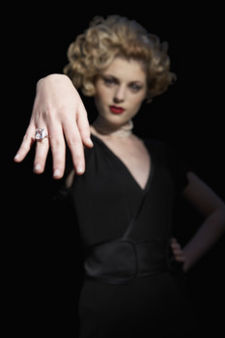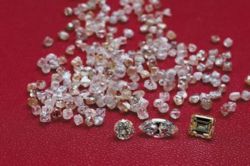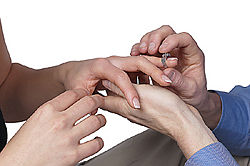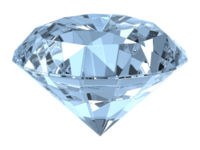Diamond
From Giftypedia
When it comes to a special gift to commemorate a special occasion or milestone, the diamond has no competition. In ancient times, the diamond symbolized wealth and status. Nothing has changed. Diamonds truly are a Girl's Best Friend. Diamond jewelry is the most desired jewelry among the ladies.
The diamond is the birthstone of April and the anniversary gemstone for the thirtieth and sixtieth anniversaries.
Diamonds are Forever
The tradition of giving a diamond engagement ring as a promise for marriage dates back to 1477 when Archduke Maximilian of Austria presented Mary of Burgundy a gold ring set with a diamond to profess his love. In ancient Egypt, it was believed that the vein of love ran from the fourth finger directly to the heart. Thus the tradition of wearing the ring that symbolized the love of the heart on the fourth finger. Diamond engagement rings became so popular by the 17th century, that if a bride did not have one, she was considered of little status.
Today, a trendy way to help conserve the planet and create an earth-friendly wedding, is to use diamonds passed down from previous generations for the engagement ring.
Diamond eternity rings, a circle of diamonds creating a continuous circle around a band with no beginning and no end, symbolize ever-lasting love. A popular gift for special anniversaries to proclaim eternal love from the giver, they are also given for other major milestones in a person's life, such as the birth of a child.
Before You Buy
| Types of Diamonds | Diamond Cuts |
|---|---|
|
Pink Diamond - the world's most rare and valuable diamond. White Diamond - produced by mines all over the world in a wide variety of shapes and sizes. Champagne Diamond - naturally colored diamonds that are produced in a wide range of colors from light straw to rich cognac. Pink Champagne Diamond - command a higher price per carat than champagne diamonds. These stones display slight to bold flashes of pink in their fire. Yellow Diamond - come in a broad range of shades ranging from light yellow to a rich canary color. Blue Diamond - available in a wide range of shades, from the blue of the sky to a more "steely" color than sapphire. Green Diamond - usually penetration of the color is not very deep and is often removed during the fashioning of the stone. Cubic Zirconia - the most commonly encountered diamond simulant. All commercial CZ is formed in laboratories. However, it is also found in nature. In both its synthetic and natural forms, CZ is colorless but color can be introduced. A thermal pen tester can quickly and easily detect CZ. |
Round - the most popular cut of diamonds. The Round cut is also the most brilliant of all the cuts. Asscher - fancy shapes are less expensive than rounds. Look for a nice length to width ratio. Cushion - also known as "pillow cut" or "candlelight". Names derive from being viewed originally by candlelight rather than the modern light bulb. The Cushion is a unique cut in an antique style similar to an Old Mine or Oval cut. Cushions feature rounded corners and larger facets. Their shape varies from square to rectangular. Emerald - rectangular with cut corners. It is a step cut as opposed to a brilliant cut. The facets are broad with flat planes resembling the steps of a stair, thus the term "step" cut. Heart - the Heart Shaped Brilliant bears some similarity to the pear shape, except that there is a cleft at the top. Often cutters may choose a Heart shape over a Pear because the rough diamond contains an inclusion located in the cleft. The skill of the cutter can make a great difference in the beauty of this cut. The shape appeal is especially important with Hearts. Marquise - the Marquise is a traditional shape. This is probably the fourth most popular shape behind the Round, Princess and Oval. Oval - not as popular for solitaires, but very popular for three stone anniversary rings, with two matching diamonds on the sides. Pear - mostly used in pendants, the Pear shape diamond is shaped in a tear drop shape and has fairly good proportions to refract light well. Princess - a square cut diamond that has refractive properties almost like the Round brilliant. The Princess is the preferred square cut shape over Radiant. Radiant Popular before the Princess shape was around, the Radiant has more facets than a princess, but has the corners trimmed like the Emerald shape. This shape is not widely popular. |
| Diamond Grading (The 4 C's) |
|---|
|
A diamond's cost is based on these characteristics:
|
Buyer Beware
There are some jewelers that are using glass to fill in cracks on the stone. This practice is referred to as clarity enhanced. Clarity enhanced diamonds should sell for half the price of a comparable, non-enhanced stone. Many times these clarity enhanced stones will be sold in the wholesale diamond districts without disclosure or an honest description of the procedure.[1]
When shopping for a diamond, check out the online market as well as the traditional market. Be sure to do your homework. Stick with a knowledgeable, reputable establishment. For expensive stones, consult a certified gemologist appraiser to verify that your stone is as advertised. Shop for quality over size. Take the extra time to get it right and you'll glad of your decision, because a diamond is an investment in your future.
Did You Know?
- The Greek word "adamas" meaning "invincible" is the root of the word diamond.
- Diamond is the hardest natural mineral scoring 10 on the Mohs scale, Sapphire is the second hardest.
- Diamonds are carried to the earth's surface by volcanic eruptions.
- While most diamonds used as gemstones are clear or “white diamonds,” diamonds come in a variety of colors. They vary from pale pinks and blues to bright yellow, oranges, greens and browns.
- Diamonds were thought to cure the mentally ill, ward off nightmares and impart virtue and courage in battle.
- Greeks believed that the fire in the diamond reflected the constant flame of love.
References
- ↑ Secrets of the Jewelry Industry: What Your Jeweler Won’t Tell You by Morgan Korn | Daily Ticker, February 8th, 2013 on Yahoo! Finance
Related Articles






 Printer Friendly
Printer Friendly
